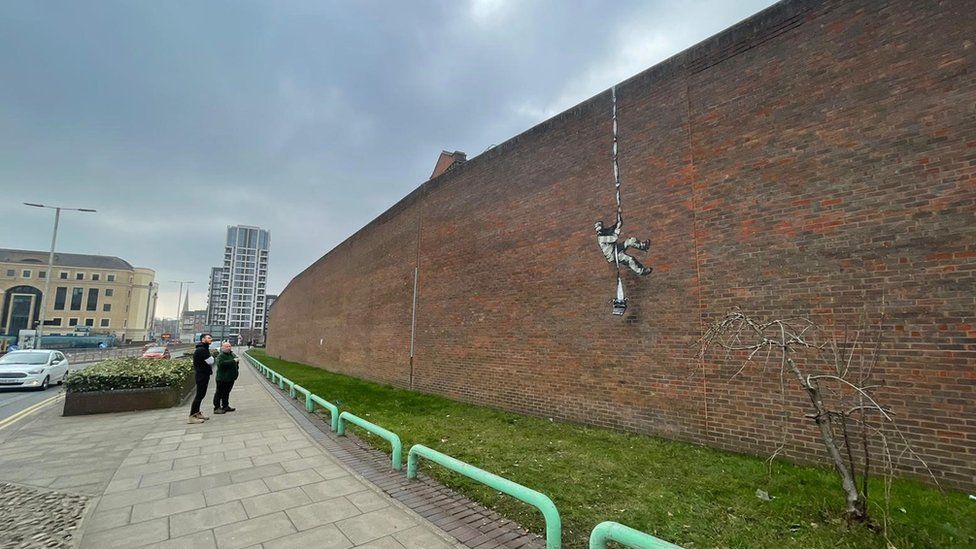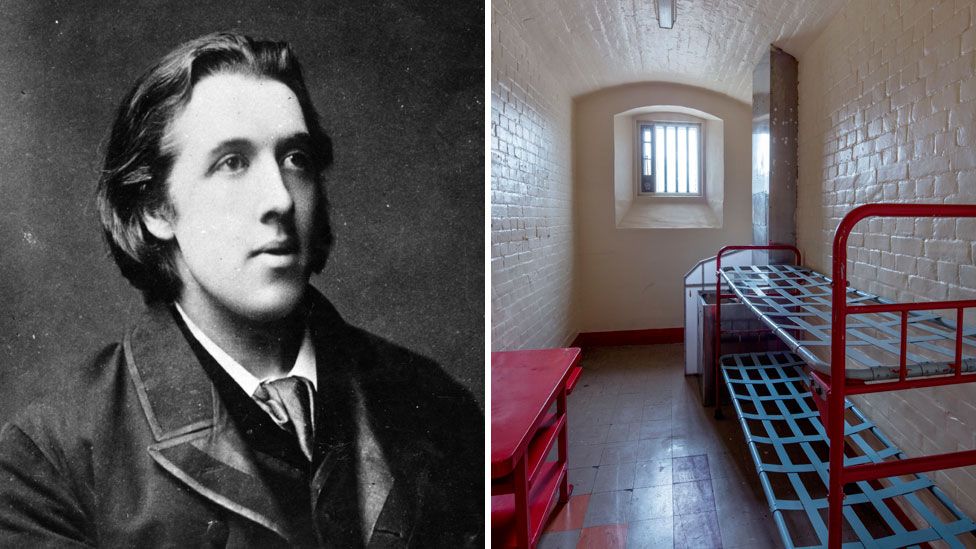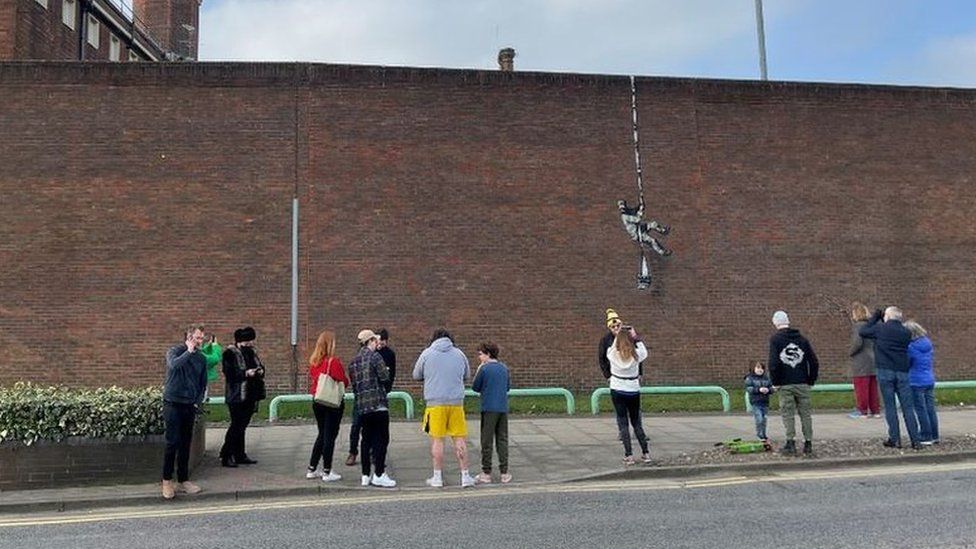Art
Possible 'Banksy' artwork appears on Reading prison wall – BBC News

An artwork bearing the hallmarks of street artist Banksy has appeared on the side of Reading Prison overnight.
The picture shows a prisoner – possibly resembling famous inmate Oscar Wilde – escaping on a rope made of bedsheets tied to a typewriter.
Campaigners have been fighting to see the former jail turned into an arts hub rather than sold off for housing.
The “guerrilla artist” has not yet claimed the work but an expert said it did “appear to be a new Banksy”.
The jail famously housed Wilde between 1895 and 1897 and was immortalised by his poem Ballad of Reading Gaol during his stay, which reflected on the brutality of the Victorian penal system.
He was convicted after his affair with Lord Alfred Douglas was exposed.


The prison has been derelict since 2013 and was put up for sale by the government in 2019.
However, a deal to sell the Grade II-listed building to developers fell through last year and Reading council said it hoped to revive its bid to turn it into an arts complex.
Hollywood actors Sir Kenneth Branagh, Natalie Dormer and Dame Judi Dench are among the stars who have lent their support to the campaign.
Banksy expert and vice-chancellor of Arts University Bournemouth, Prof Paul Gough, described the artwork as “pretty compelling” and said the quality of the painting suggested it was done by someone “who knows how to paint and has got a lot of practice at painting up a scaffold in the dead of night”.
He added: “At the moment it would take a good copier to get that right.”


Discussing the artwork’s message, he said: “It’s possibly a comment on the prison’s potential use as an arts centre, but the fact that it’s got a type-writer and that it’s all about paper and writing might be some sort of commentary on what’s happening with news media and Facebook.”
Vince John, from the 1loveart gallery in Bristol, which sells urban and street art, said: “I believe this is an example of Banksy’s street work at its best, being both humorous and politically poignant. A great piece of work and a brilliant social commentary.”
The art curator said he thought it referenced Oscar Wilde and could be a “nod of encouragement for the use of the building as a cultural and arts centre… now it has its crowd-puller and star exhibit to get things moving in the right direction”.



At the scene
Andre Rhoden-Paul, BBC South


Residents flocked in their droves to take in the new possible Banksy street art that appeared overnight on the wall of HMP Reading.
Many were asking each other if the graffiti had been confirmed as genuine or not.
But that did not stop them taking selfies with Reading’s latest attraction, which was stencilled on the towering brick wall under a seemingly out-of-use CCTV camera.
People passing by in cars also craned their necks out of windows to see what the fuss was about.



Toby Davies, artistic director of Reading-based Rabble Theatre, said if it is genuine “it’s amazing that Banksy has recognised the cultural significance of Reading’s extraordinary gaol”.
He added: “In the right hands, this gaol will evolve Reading into an internationally recognised historical and cultural destination, built on the values of acceptance and diversity. Dare I say it, it looks like Banksy agrees.”
Prof Gough added: “It draws attention to the town, it brings people out on the street, they then have a conversation and so public art is suddenly given a foreground at a time when people do want that level of diversion – and I think that’s terrific.”
Reading resident Marcus Edgar said he thought the artwork was a great way of raising awareness and “keeping that campaign alive and not selling it off to some developer”.
Eloise Wylie agreed: “If it is real then that’s really good. It’s quite significant and really nice to support that campaign.”
Reading East MP Matt Rodda said: “I’d like to thank Banksy, or whoever else painted this, for their support for the campaign to save Reading Gaol… This unique historic building should be saved for future generations.”
The Ministry of Defence, which owns the building, has not yet responded to a BBC request for comment.



Follow BBC South on Facebook, Twitter, or Instagram. Send your story ideas to south.newsonline@bbc.co.uk.
Art
Art and Ephemera Once Owned by Pioneering Artist Mary Beth Edelson Discarded on the Street in SoHo – artnet News
This afternoon in Manhattan’s SoHo neighborhood, people walking along Mercer Street were surprised to find a trove of materials that once belonged to the late feminist artist Mary Beth Edelson, all free for the taking.
Outside of Edelson’s old studio at 110 Mercer Street, drawings, prints, and cut-out figures were sitting in cardboard boxes alongside posters from her exhibitions, monographs, and other ephemera. One box included cards that the artist’s children had given her for birthdays and mother’s days. Passersby competed with trash collectors who were loading the items into bags and throwing them into a U-Haul.
“It’s her last show,” joked her son, Nick Edelson, who had arranged for the junk guys to come and pick up what was on the street. He has been living in her former studio since the artist died in 2021 at the age of 88.
Naturally, neighbors speculated that he was clearing out his mother’s belongings in order to sell her old loft. “As you can see, we’re just clearing the basement” is all he would say.


Photo by Annie Armstrong.
Some in the crowd criticized the disposal of the material. Alessandra Pohlmann, an artist who works next door at the Judd Foundation, pulled out a drawing from the scraps that she plans to frame. “It’s deeply disrespectful,” she said. “This should not be happening.” A colleague from the foundation who was rifling through a nearby pile said, “We have to save them. If I had more space, I’d take more.”
Edelson’s estate, which is controlled by her son and represented by New York’s David Lewis Gallery, holds a significant portion of her artwork. “I’m shocked and surprised by the sudden discovery,” Lewis said over the phone. “The gallery has, of course, taken great care to preserve and champion Mary Beth’s legacy for nearly a decade now. We immediately sent a team up there to try to locate the work, but it was gone.”
Sources close to the family said that other artwork remains in storage. Museums such as the Guggenheim, Tate Modern, the Museum of Modern Art, the Brooklyn Museum, and the Whitney currently hold her work in their private collections. New York University’s Fales Library has her papers.
Edelson rose to prominence in the 1970s as one of the early voices in the feminist art movement. She is most known for her collaged works, which reimagine famed tableaux to narrate women’s history. For instance, her piece Some Living American Women Artists (1972) appropriates Leonardo da Vinci’s The Last Supper (1494–98) to include the faces of Faith Ringgold, Agnes Martin, Yoko Ono, and Alice Neel, and others as the apostles; Georgia O’Keeffe’s face covers that of Jesus.


A lucky passerby collecting a couple of figurative cut-outs by Mary Beth Edelson. Photo by Annie Armstrong.
In all, it took about 45 minutes for the pioneering artist’s material to be removed by the trash collectors and those lucky enough to hear about what was happening.
Dealer Jordan Barse, who runs Theta Gallery, biked by and took a poster from Edelson’s 1977 show at A.I.R. gallery, “Memorials to the 9,000,000 Women Burned as Witches in the Christian Era.” Artist Keely Angel picked up handwritten notes, and said, “They smell like mouse poop. I’m glad someone got these before they did,” gesturing to the men pushing papers into trash bags.
A neighbor told one person who picked up some cut-out pieces, “Those could be worth a fortune. Don’t put it on eBay! Look into her work, and you’ll be into it.”
Follow Artnet News on Facebook:
Want to stay ahead of the art world? Subscribe to our newsletter to get the breaking news, eye-opening interviews, and incisive critical takes that drive the conversation forward.
Art
Biggest Indigenous art collection – CTV News Barrie
[unable to retrieve full-text content]
Biggest Indigenous art collection CTV News Barrie





Source link
Art
Why Are Art Resale Prices Plummeting? – artnet News


Welcome to the Art Angle, a podcast from Artnet News that delves into the places where the art world meets the real world, bringing each week’s biggest story down to earth. Join us every week for an in-depth look at what matters most in museums, the art market, and much more, with input from our own writers and editors, as well as artists, curators, and other top experts in the field.
The art press is filled with headlines about trophy works trading for huge sums: $195 million for an Andy Warhol, $110 million for a Jean-Michel Basquiat, $91 million for a Jeff Koons. In the popular imagination, pricy art just keeps climbing in value—up, up, and up. The truth is more complicated, as those in the industry know. Tastes change, and demand shifts. The reputations of artists rise and fall, as do their prices. Reselling art for profit is often quite difficult—it’s the exception rather than the norm. This is “the art market’s dirty secret,” Artnet senior reporter Katya Kazakina wrote last month in her weekly Art Detective column.
In her recent columns, Katya has been reporting on that very thorny topic, which has grown even thornier amid what appears to be a severe market correction. As one collector told her: “There’s a bit of a carnage in the market at the moment. Many things are not selling at all or selling for a fraction of what they used to.”
For instance, a painting by Dan Colen that was purchased fresh from a gallery a decade ago for probably around $450,000 went for only about $15,000 at auction. And Colen is not the only once-hot figure floundering. As Katya wrote: “Right now, you can often find a painting, a drawing, or a sculpture at auction for a fraction of what it would cost at a gallery. Still, art dealers keep asking—and buyers keep paying—steep prices for new works.” In the parlance of the art world, primary prices are outstripping secondary ones.
Why is this happening? And why do seemingly sophisticated collectors continue to pay immense sums for art from galleries, knowing full well that they may never recoup their investment? This week, Katya joins Artnet Pro editor Andrew Russeth on the podcast to make sense of these questions—and to cover a whole lot more.
Follow Artnet News on Facebook:
Want to stay ahead of the art world? Subscribe to our newsletter to get the breaking news, eye-opening interviews, and incisive critical takes that drive the conversation forward.
-
Media9 hours ago
DJT Stock Rises. Trump Media CEO Alleges Potential Market Manipulation. – Barron's
-
Media11 hours ago
Trump Media alerts Nasdaq to potential market manipulation from 'naked' short selling of DJT stock – CNBC
-
Investment10 hours ago
Private equity gears up for potential National Football League investments – Financial Times
-
Media23 hours ago
DJT Stock Jumps. The Truth Social Owner Is Showing Stockholders How to Block Short Sellers. – Barron's
-



 Health23 hours ago
Health23 hours agoType 2 diabetes is not one-size-fits-all: Subtypes affect complications and treatment options – The Conversation
-
Business23 hours ago
Tofino, Pemberton among communities opting in to B.C.'s new short-term rental restrictions – Vancouver Sun
-
Business22 hours ago
A sunken boat dream has left a bad taste in this Tim Hortons customer's mouth – CBC.ca
-
News21 hours ago
Best in Canada: Jets Beat Canucks to Finish Season as Top Canadian Club – The Hockey News



